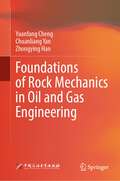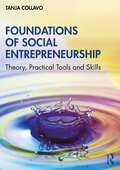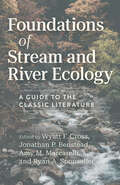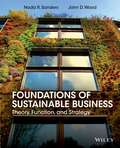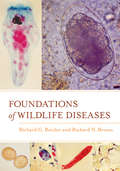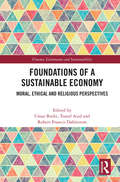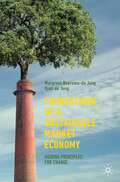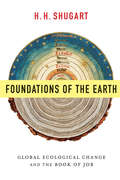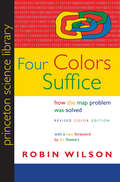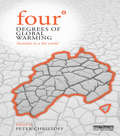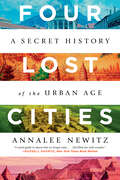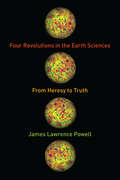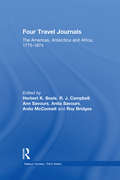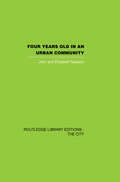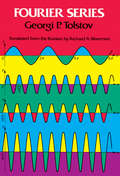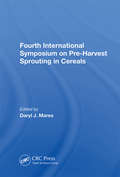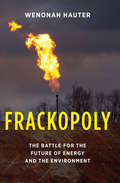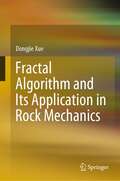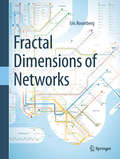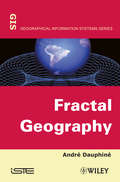- Table View
- List View
Foundations of Rock Mechanics in Oil and Gas Engineering
by Yuanfang Cheng Chuanliang Yan Zhongying HanThis book introduces the basic theoretical knowledge of rock mechanics and its application in petroleum engineering. It covers the gamut of the formulas and calculations for petroleum engineers that have been compiled over decades, while others are meant to help guide the engineer through some of the more recent breakthroughs in the industry’s technology.The topics are introduced at a level that should give a good basic understanding of the subject:• Basic concepts of stress and strain• Experimental method of rock mechanics• Rock deformation and strength characteristics• Rock strength failure criterion• In situ stress state• Application method of rock mechanics theory in the field of wellbore stability• Application method of rock mechanics theory in the field of sand production• Application method of rock mechanics theory in the field of hydraulic fracturing.This textbook contains abundant figures, illustrations, and tables, providing valuable examples and exercises.Key Features and Benefits for the Reader: • Helps in understanding the basic concepts of rock mechanics• Applies rock mechanics theory and method to various fields of petroleum engineering• Includes a large number of calculations, tables, and equations that are very useful for petroleum engineers• Presents new and updated sections in rock mechanics of petroleum engineering.
Foundations of Social Entrepreneurship: Theory, Practical Tools and Skills
by Tanja CollavoFoundations of Social Entrepreneurship presents definitions of social entrepreneurship, explains its benefits and challenges, describes the components of an ecosystem of support, and presents practical tools to approach social entrepreneurial projects. It is designed to be easily approachable by anyone without prior in-depth knowledge of the subject. The book is divided into two parts; the first provides readers with theoretical foundations to understand the phenomenon of social entrepreneurship, its different interpretations, the context in which it developed, and its socio-economic function. The second part of the book covers what it takes to create and manage a social entrepreneurial initiative. Pedagogical features are incorporated throughout to aid learning. They include summary tables, international case studies of social entrepreneurs from both developed and emerging economies, as well as suggested exercises and examples of how the tools presented are used in practice. Truly global in its scope, with a strong emphasis on combining theory with practice, this text should be core reading for advanced undergraduate and postgraduate students studying Social Entrepreneurship, Enterprise, and Responsible Business. Online resources include links to resources, chapter-by-chapter PowerPoint slides and instructor's manual.
Foundations of Stream and River Ecology: A Guide to the Classic Literature
by Nancy B. GrimmFor students and practitioners, a comprehensive primer on the key literature in stream and river ecology. The study of streams and rivers combines ecology, chemistry, hydrology, and geology to reveal the factors that control the biological diversity and functioning of these unique ecosystems. Although stream ecology is a relatively young discipline, foundational papers published over the past half century have shaped our current understanding of these ecosystems and have informed our efforts to manage and protect them. Organized by topics such as the physical template, community structure, food webs, ecosystem energetics, and nutrient dynamics, the chapters of this book offer summaries of the key literature, historical and contextual information, and insightful discussions of how past research has influenced present studies and may shape future work.
Foundations of Sustainable Business: Theory, Function, and Strategy
by Nada R. Sanders; John D. WoodSustainability as a strategic priority for all aspects of business, the text clearly defines all key concepts and shows how social, economic, and environmental trends are interconnected and relevant to corporate strategy. While the text provides an honest look at climate change, human trafficking, and environmental issues such as water shortage and ecosystem health,all normative guidance is based on traditional business value propositions, taking into account cost, risk, strategy, marketing potential, and operational feasibility.
Foundations of Wildlife Diseases
by Richard N. Brown Richard G. BotzlerFoundations of Wildlife Diseases is a comprehensive overview of the basic principles that govern the study of wildlife diseases. The authors integrate theoretical foundations with a thorough examination of the factors that can affect the health and fitness of animals. They include specific information on a wide array of infectious agents such as bacteria, viruses, arthropods, fungi, protista, and helminths, as well as immunity to these agents. Also provided is a foundation for the study of noninfectious diseases, cancers, and prion diseases that affect wildlife. Supporting students, faculty, and researchers in areas related to wildlife management, biology, and veterinary sciences, this volume fills an important gap in wildlife disease resources, focusing on mammalian and avian wildlife while also considering reptiles and amphibians.Foundations of Wildlife Diseases provides students with a structure for thinking about and understanding infective agents and their interactions with wildlife. Each chapter includes an outline, select definitions and concepts, an overview and summary, and literature cited.
Foundations of a Sustainable Economy: Moral, Ethical and Religious Perspectives (Finance, Governance and Sustainability)
by Umar BurkiThis book addresses current practices related to sustainable development, its challenges and the future. People belonging to different genders regardless of their age, social class and education should be equal as citizens and individuals, and identical in their rights and responsibilities. The business sector, authorities, societies and religious circles have the potential to play a fundamental role in curbing social ills and the degradation of the environment in this modern world. The authors of this book argue that without good governance, the status of a human being is unlikely to improve. They make the case that to achieve sustainability, government, society and the economy must ensure a platform for people to participate in decision-making and benefit from the rights they are accorded. By covering a range of perspectives across economic, social and moral life, the book will shed light on the problems and possible solutions to sustainable development and the triple bottom line, of people, planet and profit, under the umbrella of morals and divine law. This will be a useful guide for undergraduate and postgraduate students across multiple disciplines, such as economics, religious studies, business studies, political science, anthropology and sociology.
Foundations of a Sustainable Market Economy: Guiding Principles for Change
by Gjalt de Jong Margreet Boersma-de JongThe free market underpins our economy and our way of thinking around enterprise and value, but it is also a major factor in the sustainability problems that we now live with. Climate change, child labour and oil spills are just a few of the many problems associated with our economic activity and, although many companies have made an effort to produce more sustainably, the pace of change is much too slow. This engaging and accessible textbook teaches students the relationship between the economy and sustainability, assessing the hand of the free market on company behaviour and, ultimately, providing a framework for transition to a sustainable economy.Using case studies and optional assessment questions, this textbook explains to students what a market is at the macro level and then translates the effects of the market to industries and subsequently to the strategic choices of companies at the micro level. It adopts a model of 8 guiding principles that underpin the current free market economy and 8 guiding principles for the sustainable market economy. Switching these deeply held principles will be essential to any serious transition to a sustainable economy.
Foundations of the Earth
by H. H. Shugart"Where were you when I laid the foundation of the earth?" God asks Job in the "Whirlwind Speech," but Job cannot reply. This passage -- which some environmentalists and religious scholars treat as a "green" creation myth -- drives H. H. Shugart's extraordinary investigation, in which he uses verses from God's speech to Job to explore the planetary system, animal domestication, sea-level rise, evolution, biodiversity, weather phenomena, and climate change.Shugart calls attention to the rich resonance between the Earth's natural history and the workings of religious feeling, the wisdom of Bible scripture, and the arguments of Bible ethicists. The divine questions that frame his study are quintessentially religious, and the global changes humans have wrought on the Earth operate in not only the physical, chemical, and biological spheres but also the spiritual realm. Shugart offers a universal framework for recognizing and confronting the global challenges humans now face: the relationship between human technology and large-scale environmental degradation; the effect of invasive species on the integrity of ecosystems; the role of humans in generating wide biotic extinctions; and the future functioning of our oceans and tides.
Foundations of the Earth
by H. H. Shugart"Where were you when I laid the foundation of the earth?" God asks Job in the "Whirlwind Speech," but Job cannot reply. This passage -- which some environmentalists and religious scholars treat as a "green" creation myth -- drives H. H. Shugart's extraordinary investigation, in which he uses verses from God's speech to Job to explore the planetary system, animal domestication, sea-level rise, evolution, biodiversity, weather phenomena, and climate change.Shugart calls attention to the rich resonance between the Earth's natural history and the workings of religious feeling, the wisdom of Bible scripture, and the arguments of Bible ethicists. The divine questions that frame his study are quintessentially religious, and the global changes humans have wrought on the Earth operate in not only the physical, chemical, and biological spheres but also the spiritual realm. Shugart offers a universal framework for recognizing and confronting the global challenges humans now face: the relationship between human technology and large-scale environmental degradation; the effect of invasive species on the integrity of ecosystems; the role of humans in generating wide biotic extinctions; and the future functioning of our oceans and tides.
Foundations of the Earth
by H. H. Shugart"Where were you when I laid the foundation of the earth?" God asks Job in the "Whirlwind Speech," but Job cannot reply. This passage -- which some environmentalists and religious scholars treat as a "green" creation myth -- drives H. H. Shugart's extraordinary investigation, in which he uses verses from God's speech to Job to explore the planetary system, animal domestication, sea-level rise, evolution, biodiversity, weather phenomena, and climate change.Shugart calls attention to the rich resonance between the Earth's natural history and the workings of religious feeling, the wisdom of Bible scripture, and the arguments of Bible ethicists. The divine questions that frame his study are quintessentially religious, and the global changes humans have wrought on the Earth operate in not only the physical, chemical, and biological spheres but also the spiritual realm. Shugart offers a universal framework for recognizing and confronting the global challenges humans now face: the relationship between human technology and large-scale environmental degradation; the effect of invasive species on the integrity of ecosystems; the role of humans in generating wide biotic extinctions; and the future functioning of our oceans and tides.
Foundations of the Earth: Global Ecological Change and the Book of Job
by H.H. Shugart"Where were you when I laid the foundation of the earth?" God asks Job in the "Whirlwind Speech," but Job cannot reply. This passage—which some environmentalists and religious scholars treat as a "green" creation myth—drives renowned ecologist H. H. Shugart's extraordinary investigation, in which he uses verses from God's speech to Job to explore the planetary system, animal domestication, sea-level rise, evolution, biodiversity, weather phenomena, and climate change. Shugart calls attention to the rich resonance between the Earth's natural history and the workings of religious feeling, the wisdom of biblical scripture, and the arguments of Bible ethicists. The divine questions that frame his study are quintessentially religious, and the global changes humans have wrought on the Earth operate not only in the physical, chemical, and biological spheres but also in the spiritual realm. Shugart offers a universal framework for recognizing and confronting the global challenges humans now face: the relationship between human technology and large-scale environmental degradation, the effect of invasive species on the integrity of ecosystems, the role of humans in generating wide biotic extinctions, and the future of our oceans and tides.
Four Colors Suffice: How the Map Problem Was Solved - Revised Color Edition (Princeton Science Library #128)
by Robin WilsonOn October 23, 1852, Professor Augustus De Morgan wrote a letter to a colleague, unaware that he was launching one of the most famous mathematical conundrums in history--one that would confound thousands of puzzlers for more than a century. This is the amazing story of how the "map problem" was solved. The problem posed in the letter came from a former student: What is the least possible number of colors needed to fill in any map (real or invented) so that neighboring counties are always colored differently? This deceptively simple question was of minimal interest to cartographers, who saw little need to limit how many colors they used. But the problem set off a frenzy among professional mathematicians and amateur problem solvers, among them Lewis Carroll, an astronomer, a botanist, an obsessive golfer, the Bishop of London, a man who set his watch only once a year, a California traffic cop, and a bridegroom who spent his honeymoon coloring maps. In their pursuit of the solution, mathematicians painted maps on doughnuts and horseshoes and played with patterned soccer balls and the great rhombicuboctahedron. It would be more than one hundred years (and countless colored maps) later before the result was finally established. Even then, difficult questions remained, and the intricate solution--which involved no fewer than 1,200 hours of computer time--was greeted with as much dismay as enthusiasm. Providing a clear and elegant explanation of the problem and the proof, Robin Wilson tells how a seemingly innocuous question baffled great minds and stimulated exciting mathematics with far-flung applications. This is the entertaining story of those who failed to prove, and those who ultimately did prove, that four colors do indeed suffice to color any map. This new edition features many color illustrations. It also includes a new foreword by Ian Stewart on the importance of the map problem and how it was solved.
Four Degrees of Global Warming: Australia in a Hot World
by Peter ChristoffAt Copenhagen in December 2009, the international community agreed to limit global warming to below two degrees Celsius to avoid the worst impacts of human-induced climate change. However climate scientists agree that current national emissions targets collectively will still not achieve this goal. Instead, the ‘ambition gap’ between climate science and climate policy is likely to lead to average global warming of around four degrees Celsius by or before 2100. If a ‘Four Degree World’ is the de facto goal of policy, we urgently need to understand what this world might look like. Four Degrees of Global Warming: Australia in a Hot World outlines the expected consequences of this world for Australia and its region. Its contributors include many of Australia’s most eminent and internationally recognized climate scientists, climate policy makers and policy analysts. They provide an accessible, detailed, dramatic, and disturbing examination of the likely impacts of a Four Degree World on Australia’s social, economic and ecological systems. The book offers policy makers, politicians, students, and anyone interested climate change, access to the most recent research on potential Australian impacts of global warming, and possible responses.
Four Lost Cities: A Secret History Of The Urban Age
by Annalee NewitzA quest to explore some of the most spectacular ancient cities in human history—and figure out why people abandoned them. In Four Lost Cities, acclaimed science journalist Annalee Newitz takes readers on an entertaining and mind-bending adventure into the deep history of urban life. Investigating across the centuries and around the world, Newitz explores the rise and fall of four ancient cities, each the center of a sophisticated civilization: the Neolithic site of Çatalhöyük in Central Turkey, the Roman vacation town of Pompeii on Italy’s southern coast, the medieval megacity of Angkor in Cambodia, and the indigenous metropolis Cahokia, which stood beside the Mississippi River where East St. Louis is today. Newitz travels to all four sites and investigates the cutting-edge research in archaeology, revealing the mix of environmental changes and political turmoil that doomed these ancient settlements. Tracing the early development of urban planning, Newitz also introduces us to the often anonymous workers—slaves, women, immigrants, and manual laborers—who built these cities and created monuments that lasted millennia. Four Lost Cities is a journey into the forgotten past, but, foreseeing a future in which the majority of people on Earth will be living in cities, it may also reveal something of our own fate.
Four Revolutions in the Earth Sciences
by James Lawrence PowellJames Lawrence Powell serves as executive director of the National Physical Science Consortium, a partnership among government agencies and laboratories, industry, and higher education dedicated to increasing the number of American citizens with graduate degrees in the physical sciences and related engineering fields, emphasizing recruitment of a diverse applicant pool that includes women and minorities. He received his Ph.D from the Massachusetts Institute of Technology and has taught at Oberlin College and served as its acting president. He has also been president of Franklin and Marshall College, Reed College, the Franklin Institute Science Museum in Philadelphia, and the Los Angeles County Museum of Natural History. Presidents Ronald Reagan and George H. W. Bush both appointed Powell to the National Science Board. He is also the author of The Inquisition of Climate Science.
Four Revolutions in the Earth Sciences: From Heresy to Truth
by James Lawrence PowellJames Lawrence Powell serves as executive director of the National Physical Science Consortium, a partnership among government agencies and laboratories, industry, and higher education dedicated to increasing the number of American citizens with graduate degrees in the physical sciences and related engineering fields, emphasizing recruitment of a diverse applicant pool that includes women and minorities. He received his Ph.D from the Massachusetts Institute of Technology and has taught at Oberlin College and served as its acting president. He has also been president of Franklin and Marshall College, Reed College, the Franklin Institute Science Museum in Philadelphia, and the Los Angeles County Museum of Natural History. Presidents Ronald Reagan and George H. W. Bush both appointed Powell to the National Science Board. He is also the author of The Inquisition of Climate Science.
Four Revolutions in the Earth Sciences: From Heresy to Truth
by James PowellOver the course of the twentieth century, scientists came to accept four counterintuitive yet fundamental facts about the Earth: deep time, continental drift, meteorite impact, and global warming. When first suggested, each proposition violated scientific orthodoxy and was quickly denounced as scientific—and sometimes religious—heresy. Nevertheless, after decades of rejection, scientists came to accept each theory. The stories behind these four discoveries reflect more than the fascinating push and pull of scientific work. They reveal the provocative nature of science and how it raises profound and sometimes uncomfortable truths as it advances. For example, counter to common sense, the Earth and the solar system are older than all of human existence; the interactions among the moving plates and the continents they carry account for nearly all of the Earth's surface features; and nearly every important feature of our solar system results from the chance collision of objects in space. Most surprising of all, we humans have altered the climate of an entire planet and now threaten the future of civilization. This absorbing scientific history is the only book to describe the evolution of these four ideas from heresy to truth, showing how science works in practice and how it inevitably corrects the mistakes of its practitioners. Scientists can be wrong, but they do not stay wrong. In the process, astonishing ideas are born, tested, and over time take root.
Four Travel Journals / The Americas, Antarctica and Africa / 1775-1874 (Hakluyt Society, Third Series)
by R. J. Campbell Anita Mcconnell Ann Savours Herbert K. Beals Roy BridgesThis volume offers annotated texts with biographical and historical introductions of four previously unpublished travel journals from the period 1775-1874. The first of these is the journal of a participant in a Spanish expedition sent from Mexico to explore the north-west coast of America. From the outset, difficulties plagued the voyage. Bodega's ship, a small schooner named Sonora, was not designed for open-ocean voyaging. A landing party was attacked and killed; midway into the voyage the Sonora became separated from her flagship; and later she was nearly capsized by a massive wave. Bodega's journal records the voyage's travails, hardships, discoveries, and eventual return. Next comes the journal of Commander Stokes, who served in command of HMS Beagle, under Captain P. P. King during the survey of the Straits of Magellan in 1827. This is an account of a detached operation, in very difficult weather conditions, in the western part of the strait. It is introduced by remarks on the expedition and the hydrographic history of the strait from its discovery to the inception of the survey and supplemented by remarks from Captain King's account and also that of the clerk, Macdouall. The third text is the journal of a young midshipman in HMS Chanticleer, a small vessel commanded by Henry Foster, RN, who had recently been elected a Fellow of the Royal Society for his scientific work in the Arctic. The voyage of 1828-31 was to make observations in the South Atlantic to determine the shape of the Earth and to ascertain the longitudes of a number of ports. Kay's lively diary describes the Chanticleer's encounters with warships of the Brazilian navy, largely manned by Englishmen. He records his struggle to take observations at Deception Island during gales and snowstorms, and near Cape Horn in fierce squalls and constant chilling rain, nevertheless remaining cheerful in the company of his fellow midshipmen. The final piece is the diary of Jacob Wainwright, the young
Four years Old in an Urban Community
by Elizabeth Newson John NewsonJohn and Elizabeth Newson investigate the upbringing of seven hundred Nottingham children as they reach the age of four. Parents are interviewed in their homes with a realistic yet human approach and the minimum of technical jargon, and the open-ended questions allow them to produce 'a detailed and descriptive study of how parents do in fact treat their children and - equally important - how children treat their parents.' No one can fail to be impressed by the concern and perceptiveness shown by mothers of all classes, different though their approach may be to the common problems of the parent - child relationship. This book was first published in 1968.
Fourier Series
by Georgi P. TolstovRichard A. Silverman's series of translations of outstanding Russian textbooks and monographs is well-known to people in the fields of mathematics, physics, and engineering. The present book is another excellent text from this series, a valuable addition to the English-language literature on Fourier series.This edition is organized into nine well-defined chapters: Trigonometric Fourier Series, Orthogonal Systems, Convergence of Trigonometric Fourier Series, Trigonometric Series with Decreasing Coefficients, Operations on Fourier Series, Summation of Trigonometric Fourier Series, Double Fourier Series and the Fourier Integral, Bessel Functions and Fourier-Bessel Series, and the Eigenfunction Method and its Applications to Mathematical Physics. Every chapter moves clearly from topic to topic and theorem to theorem, with many theorem proofs given. A total of 107 problems will be found at the ends of the chapters, including many specially added to this English-language edition, and answers are given at the end of the text. Richard Silverman's excellent translation makes this book readily accessible to mathematicians and math students, as well as workers and students in the fields of physics and engineering. He has also added a bibliography, containing suggestions for collateral and supplementary reading. 1962 edition.
Fourth International Symposium On Pre-harvest Sprouting In Cereals
by Daryl MaresA major constraint on the production of high-quality grain around the world, pre-harvest sprouting in cereal crops causes substantial economic losses to producers and disrupts the processing, distribution, marketing, and storage of grain products. The solution to this problem must include a better understanding of the phenomenon, the development of
Frackopoly: The Battle for the Future of Energy and the Environment
by Wenonah Hauter&“The definitive story on how big oil and gas corporations captured our political system . . . and the growing grassroots movement to retake our democracy&” (Mark Ruffalo). Over the past decade a new and controversial energy extraction method known as hydraulic fracturing, commonly referred to as fracking, has rocketed to the forefront of US energy production. With fracking, millions of gallons of water, dangerous chemicals, and sand are injected under high pressure deep into the earth, fracturing hard rock to release oil and gas. Wenonah Hauter, one of the nation&’s leading public interest advocates, argues that the rush to fracking is dangerous to the environment and treacherous to human health. Frackopoly describes how the fracking industry began; the technologies that make it possible; and the destruction and poisoning of clean water sources with the release of harmful radiation from deep inside shale deposits, creating what the author calls &“sacrifice zones&” across the American landscape. The book also examines the powerful interests that have supported fracking, including leading environmental groups, and offers a thorough debunking of its supposed economic benefits. With a wealth of new data, Frackopoly is an essential and riveting read for anyone interested in protecting the environment and ensuring a healthy and sustainable future for all Americans. &“A passionate history and critique of the energy industry, from Standard Oil to Enron . . . . [A] journalistic exposé of fracking outrages in which aggressive entrepreneurs in pursuit of profits wreak havoc on the land and poison the water.&” —Kirkus Reviews &“A truly powerful manifesto about one of the greatest environmental fights on our planet today—from one of its greatest champions!&” —Bill McKibben, environmentalist and author of Oil and Honey
Fractal Algorithm and Its Application in Rock Mechanics
by Dongjie XueThis book focuses on learning and adapting nonlinear geometry tool in rock engineering through fractal theories, hypotheses, algorithm, practical understandings, and case studies. Understanding self-similarity and self-affinity is a prerequisite to the fractal model in rock mechanics. The book aims to provide a guide for the readers seeking to understand and build nonlinear model by fractal algorithm. The book is motivated by recent rapid advances in rock engineering in China including application of fractal theory, in addition to percolation theory. It is an essential reference to the most promising innovative rock engineering. Chapters are carefully developed to cover (1) new fractal algorithms (2) five engineering cases. This authored book addresses the issue with a holistic and systematic approach that utilizes fractal theory to nonlinear behavior in rock engineering. The book is written for researchers interested in rock and geological engineering as well as organizations engaged in underground energy practices.
Fractal Dimensions of Networks (Springerbriefs In Computer Science Ser.)
by Eric RosenbergCurrent interest in fractal dimensions of networks is the result of more than a century of previous research on dimensions. Fractal Dimensions of Networks ties the theory and methods for computing fractal dimensions of networks to the “classic” theory of dimensions of geometric objects.The goal of the book is to provide a unified treatment of fractal dimensions of sets and networks. Since almost all of the major concepts in fractal dimensions originated in the study of sets, the book achieves this goal by first clearly presenting, with an abundance of examples and illustrations, the theory and algorithms for sets, and then showing how the theory and algorithms have been applied to networks. Thus, the book presents the classical theory and algorithms for the box counting dimension for sets, and then presents the box counting dimension for networks. All the major fractal dimensions are studied, e.g., the correlation dimension, the information dimension, the Hausdorff dimension, the multifractal spectrum, as well as many lesser known dimensions. Algorithm descriptions are accompanied by worked examples, many applications of the methods are presented, and many exercises, ranging in difficulty from easy to research level, are included.
Fractal Geography
by André DauphinéOur daily universe is rough and infinitely diverse. The fractal approach clarifies and orders these disparities. It helps us to envisage new explanations of geographical phenomena, which are, however, considered as definitely understood.Written for use by geographers and researchers from similar disciplines, such as ecologists, economists, historians and sociologists, this book presents the algorithms best adapted to the phenomena encountered, and proposes case studies illustrating their applications in concrete situations.An appendix is also provided that develops programs written in Mathematica.Contents1. A Fractal World.2. Auto-similar and Self-affine Fractals.3. From the Fractal Dimension to Multifractal Spectrums.4. Calculation and Interpretation of Fractal Dimensions.5. The Fractal Dimensions of Rank-size Distributions.6. Calculation and Interpretation of Multifractal Spectrums.7. Geographical Explanation of Fractal Forms and Dynamics.8. Using Complexity Theory to Explain a Fractal World.9. Land-use Planning and Managing a Fractal Environment.
